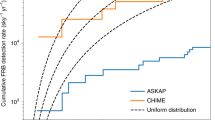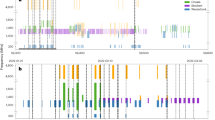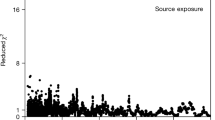Abstract
The event rate, energy distribution and time-domain behaviour of repeating fast radio bursts (FRBs) contain essential information regarding their physical nature and central engine, which are as yet unknown1,2. As the first precisely localized source, FRB 121102 (refs. 3,4,5) has been extensively observed and shows non-Poisson clustering of bursts over time and a power-law energy distribution6,7,8. However, the extent of the energy distribution towards the fainter end was not known. Here we report the detection of 1,652 independent bursts with a peak burst rate of 122 h−1, in 59.5 hours spanning 47 days. A peak in the isotropic equivalent energy distribution is found to be approximately 4.8 × 1037 erg at 1.25 GHz, below which the detection of bursts is suppressed. The burst energy distribution is bimodal, and well characterized by a combination of a log-normal function and a generalized Cauchy function. The large number of bursts in hour-long spans allows sensitive periodicity searches between 1 ms and 1,000 s. The non-detection of any periodicity or quasi-periodicity poses challenges for models involving a single rotating compact object. The high burst rate also implies that FRBs must be generated with a high radiative efficiency, disfavouring emission mechanisms with large energy requirements or contrived triggering conditions.
This is a preview of subscription content, access via your institution
Access options
Access Nature and 54 other Nature Portfolio journals
Get Nature+, our best-value online-access subscription
$29.99 / 30 days
cancel any time
Subscribe to this journal
Receive 51 print issues and online access
$199.00 per year
only $3.90 per issue
Buy this article
- Purchase on Springer Link
- Instant access to full article PDF
Prices may be subject to local taxes which are calculated during checkout




Similar content being viewed by others
Data availability
All relevant data for the 1,652 detected burst events are summarized in Supplementary Table 1. Observational data are available from the FAST archive (http://fast.bao.ac.cn) 1 year after data collection, following FAST data policy. Owing to the large data volume for these observations, interested users are encouraged to contact the corresponding author to arrange the data transfer. The data that support the findings of this study are openly available in Science Data Bank at https://doi.org/10.11922/sciencedb.01092 or https://www.scidb.cn/en/detail?dataSetId=f172ff40142c4100855724b80a085deb.
Code availability
Computational programs for the FRB121102 burst analysis and observations reported here are available at https://github.com/NAOC-pulsar/PeiWang-code. Other standard data reduction packages are available at their respective websites: PRESTO (https://github.com/scottransom/presto), HEIMDALL (http://sourceforge.net/projects/heimdall-astro/), DSPSR (http://dspsr.sourceforge.net), PSRCHIVE (http://psrchive.sourceforge.net).
Change history
15 December 2021
A Correction to this paper has been published: https://doi.org/10.1038/s41586-021-04178-8
References
Petroff, E., Hessels, J. W. T. & Lorimer, D. R. Fast radio bursts. Astron. Astrophys. Rev. 27, 4 (2019).
Cordes, J. M. & Chatterjee, S. Fast radio bursts: an extragalactic enigma. Ann. Rev. Astron. Astrophys. 57, 417–465 (2019).
Spitler, L. G. et al. A repeating fast radio burst. Nature 531, 202–205 (2016).
Chatterjee, S. et al. A direct localization of a fast radio burst and its host. Nature 541, 58–61 (2017).
Tendulkar, S. P. et al. The host galaxy and redshift of the repeating fast radio burst FRB 121102. Astrophys. J. Lett. 834, L7 (2017).
Michilli, D. et al. An extrememagneto-ionic environment associated with the fast radio burst source FRB 121102. Nature 553, 182 (2018).
Zhang, Y. G. et al. Fast radio burst 121102 pulse detection and periodicity: a machine learning approach. Astrophys. J. 866, 149 (2018).
Gourdji, K. et al. A sample of low-energy bursts from FRB 121102. Astrophys. J. Lett. 877, L19 (2019).
Li, Di. et al. FAST in space: considerations for a multibeam, multipurpose survey using China’s 500-m aperture spherical radio telescope (FAST). IEEE 19, 112–119 (2018).
Planck Collaboration et al. Planck 2015 results. XIII. Cosmological parameters. Astron. Astrophys. 594, A13 (2016).
Shannon, R. M. et al. The dispersion-brightness relation for fast radio bursts from a wide-field survey. Nature 562, 386–390 (2018).
Katz, J. I. Fast radio bursts. Prog. Part. Nucl. Phys. 103, 1–18 (2018).
Palaniswamy, D., Li, Y. & Zhang, B. Are there multiple populations of fast radio bursts? Astrophys. J. Lett. 854, L12 (2018).
Scholz, P. et al. The repeating fast radio burst FRB 121102: multi-wavelength observations and additional bursts. Astrophys. J. 833, 177 (2016).
Petroff, E. et al. FRBCAT: rhe fast radio burst catalogue. Publ. Astron. Soc. Aust. 33, e045 (2016).
Oostrum, L. C. et al. Repeating fast radio bursts with WSRT/Apertif. Astron. Astrophys. 635, A61 (2020).
Hessels, J. W. T. et al. FRB 121102 bursts show complex time-frequency structure. Astrophys. J. 876, L23 (2019).
Metzger, B. D., Berger, E. & Margalit, B. Millisecond magnetar birth connects FRB 121102 to superluminous supernovae and long-duration gamma-ray bursts. Astrophys. J. 841, 14 (2017).
Yang, Y.-P. & Zhang, B. Dispersion measure variation of repeating fast radio burst sources. Astrophys. J. 847, 22 (2017).
Lu, W. B., Kumar, P. & Zhang, B. A unified picture of Galactic and cosmological fast radio bursts. Mon. Not. R. Astron. Soc. 498, 1397 (2020).
Wadiasingh, Z. et al. The fast radio burst luminosity function and death line in the low twist magnetar model. Astrophys. J. 891, 82 (2020).
Göğüs, E. et al. Statistical properties of SGR 1806-20 bursts. Astrophys. J. Lett. 532, L121–L124 (2000).
Wang, F. Y. & Yu, H. SGR-like behaviour of the repeating FRB 121102. JCAP 03, 023 (2017).
Bagchi, M. A unified model for repeating and non-repeating fast radio bursts. Astrophys. J. Lett. 838, L16 (2017).
Smallwood, J. L., Martin, R. G. & Zhang, B. Investigation of the asteroid-neutron star collision model for the repeating fast radio bursts. Mon. Not. R. Astron. Soc. 485, 1367–1376 (2019).
Cordes, J. M. & Wasserman, I. Supergiant pulses from extragalactic neutron stars. Mon. Not. R. Astron. Soc. 457, 232–257 (2016).
Zhang, B. Fast radio bursts from interacting binary neutron star systems. Astrophys. J. Lett. 890, L24 (2020).
Metzger, B. D., Margalit, B. & Sironi, L. Fast radio bursts as synchrotron maser emission from decelerating relativistic blast waves. Mon. Not. R. Astron. Soc. 485, 4091–4106 (2019).
Beloborodov, A. M. Blast waves from magnetar flares and fast radio bursts. Preprint at https://arxiv.org/abs/1908.07743 (2019).
Kumar, P., Lu, W. & Bhattacharya, M. Fast radio burst source properties and curvature radiation model. Mon. Not. R. Astron. Soc. 468, 2726–2739 (2017).
Petroff, E. et al. A real-time fast radio burst: polarization detection and multiwavelength follow-up. Mon. Not. R. Astron. Soc. 447, 246 (2015).
Ransom, S. M. New Search Techniques for Binary Pulsars. PhD thesis, Harvard Univ. (2001).
Zhang, B. Fast radio burst energetics and detectability from high redshifts. Astrophys. J. Lett. 867, L21 (2018).
Gupta, V. et al. Estimating fast transient detection pipeline efficiencies at UTMOST via real-time injection of mock FRBs. Mon. Not. R. Astron. Soc. 501, 2316–2326 (2021).
Luo, R., Lee, K., Lorimer, D. R. & Zhang, B. On the normalized FRB luminosity function. Mon. Not. R. Astron. Soc. 481, 2320–2337 (2018).
Wang, F. Y. & Zhang, G. Q. A. Universal energy distribution for FRB 121102. Astrophys. J. 882, 108 (2019).
Lu,W. & Piro Anthony, L., Implications from ASKAP fast radio burst statistics. Astrophys. J. 883, 3796–3847 (2019).
Luo, R. et al. On the FRB luminosity function–II. Event rate density. Mon. Not. R. Astron. Soc. 494, 665–679 (2020).
Cordes, J. M., Bhat, N. D. E., Hankins, T. H., McLaughlin, M. A. & Kern, J. The brightest pulses in the universe: multifrequency observations of the Crab pulsar’s giant pulses. Astrophys. J. 612, 375–388 (2004).
The CHIME/FRB Collaboration et al. CHIME/FRB detection of eight new repeating fast radio burst sources. Preprint at https://arxiv.org/abs/1908.03507 (2019).
Oppermann, N., Yu, H. R. & Pen, U. L. On the non-Poissonian repetition pattern of FRB121102. Mon. Not. R. Astron. Soc. 475, 5109–5115 (2018).
Lomb, N. R. Least-squares frequency analysis of unequally spaced data. Astrophys. Space Sci. 39, 447–462 (1976).
Scargle, J. D. Studies in astronomical time series analysis. II. Statistical aspects of spectral analysis of unevenly spaced data. Astrophys. J. 263, 835–853 (1982).
Rajwade, K. M. et al. Possible periodic activity in the repeating FRB 121102. Mon. Not. R. Astron. Soc. 495, 3551–3558 (2020).
Cruces, M. et al. Repeating behaviour of FRB 121102: periodicity, waiting times and energy distribution. Preprint at https://arxiv.org/abs/2008.03461 (2020).
Feng, Y. I. et al. Study of PSR J1022+1001 using the FAST radio telescope. Astrophys. J. 908, 105–111 (2021).
Luo, R. et al. Diverse polarization angle swings from a repeating fast radio burst source. Nature 586, 693–696 (2020).
Zhang, C. F. et al. A highly polarised radio burst detected from SGR 1935+2154 by FAST The Astronomer’s Telegram 13699, 1–1 (2020).
Hilmarsson, G. H., et al, Rotation measure evolution of the repeating fast radio burst source FRB 121102 Astrophys. J. Lett. 908, 10–23 (2021).
Plotnikov, I. & Sironi, L. The synchrotron maser emission from relativistic shocks in fast radio bursts: 1D PIC simulations of cold pair plasmas. Mon. Not. R. Astron. Soc. 485, 3816–3833 (2019).
Wu, Q., Zhang, G. Q., Wang, F. Y. & Dai, Z. G. Understanding FRB 200428 in the synchrotron maser shock model: consistency and possible challenge. Astrophys. J. Lett. 900, L26 (2020).
Acknowledgements
This work is supported by National Natural Science Foundation of China (NSFC) programme nos. 11988101, 11725313, 11690024, 12041303, U1731238, U2031117, U1831131 and U1831207; by CAS International Partnership programme no. 114-A11KYSB20160008; by CAS Strategic Priority Research programme no. XDB23000000; the National Key R&D Program of China (no. 2017YFA0402600); and the National SKA Program of China no. 2020SKA0120200; and the Cultivation Project for FAST Scientific Payoff and Research Achievement of CAMS-CAS. S.C. and J.M.C. acknowledge support from the U.S. National Science Foundation (AAG 1815242). D.R.L. acknowledges support from the U.S. National Science Foundation awards AAG-1616042, OIA-1458952 and PHY-1430284. P.W. acknowledges support from the Youth Innovation Promotion Association CAS (ID 2021055) and CAS Project for Young Scientists in Basic Reasearch (grant YSBR-006); P.W. and C.H.N. acknowledge support from cultivation project for FAST scientific payoff and research achievement of CAMS-CAS. Q.J.Z. is supported by the Technology Fund of Guizhou Province ((2016)-4008). L.Q. is supported by the Youth Innovation Promotion Association of CAS (ID 2018075). This work made use of data from FAST, a Chinese national mega-science facility built and operated by the National Astronomical Observatories, Chinese Academy of Sciences.
Author information
Authors and Affiliations
Contributions
D.L., R.D. and W.W.Z. launched the FAST campaign; P.W., C.H.N., Y.K.Z., Y.F., N.Y.T., J.R.N., C.C.M. and L.Z. processed the data; D.L., B.Z. and P.W. drafted the paper; R.D., X.X.Z., V.G., C.J., Y.Z., D.W. and Y.L.Y. built the FAST FRB backend; L.Q., G.H., X.Y.X., Q.J.Z. and S.D. made key contributions to the overall FAST data processing pipelines; L.S., M.C. and M.K. provided salient information on FRB 121102 from other observatories, particularly Effelsberg, and contributed to the scientific analysis; S.C., J.M.C., D.R.L. and F.Y.W. contribued to the writing and analysis, including simulations of the waiting time distribution (J.M.C.). F.Y.W. and G.Q.Z. contributed to work on the time-dependence of bimodal energy distribution.
Corresponding authors
Ethics declarations
Competing interests
The authors declare no competing interests.
Additional information
Peer review information Nature thanks Victoria Kaspi and the other, anonymous, reviewer(s) for their contribution to the peer review of this work. Peer reviewer reports are available.
Publisher’s note Springer Nature remains neutral with regard to jurisdictional claims in published maps and institutional affiliations.
Extended data figures and tables
Extended Data Fig. 1 The distribution of the instrumental gain and off-pulse brightness RMS at 1.25 GHz for observations.
The upper panel indicates the gain applied for each pulses. The red dots denote the averaged gain in each day. The bottom panel shows the off-pulse brightness RMS (mK s) of the first pulse detected each day.
Extended Data Fig. 3 Left panel: Example of FRB simulations.
Upper panels (a and b) are injected and de-dispersed dynamic spectra respectively. The time series is shown in panel (c) with the red arrows pointing to simulated pulses that were detected, while the blue arrow indicates an undetected pulse. Right panel: Comparison of SNRp recovered by FRB search versus the corresponding injected values. The SNRp histograms separately indicate the injected FRB pulses (grey lines) and the mock FRBs detected (red lines).
Extended Data Fig. 4 The completeness fraction of the FAST survey to FRBs as a function of the observed fluence and detected width.
All FRBs lying in the integrated SNRf < 6 region are below PRESTO’s search threshold. The region above the integrated SNRf of 6 shows the incompleteness of our FAST detection to broad FRBs as revealed by the injections. The map was smoothed (rebin) the map with a box of 0.05 ms × 0.002 Jy ms, which ensured the presence of at least one injected pulse in most map areas. Then for a few grid points without pulses, a simple linear interpolation was used to improve the visual appearance. The colour bar on the right side indicates the detection recovery fraction.
Extended Data Fig. 5 Upper panel (a): The burst rate distribution of the isotropic equivalent energy.
Details as per Extended Data Fig. 2. The red line represents the recovered distribution by adding back the missing fraction based on the simulation. The grey shaded region is the uncertainty for a 95% confidence based on the Poisson statistical assumption in the “reconstructed” fitting. Bottom panel (b): The fluence-width distribution at 1.25 GHz for FRB 121102 bursts. The black dots indicate the 1,652 detected bursts, the colorbar is consistent with Extended Data Fig. 4. In the upper panel, the two-component lognormal (LN) distribution is separately fitted in blue dashed line and grey dot line, an overall fit for bursts is shown in green. The red line and the shaded region indicates reconstructed missing fraction of bursts detection and uncertainty.
Extended Data Fig. 6 Flux intensity and pulse width distribution of FRB 121102.
Left: Flux intensity against pulse width for the FRB 121102 bursts with peak SNRp >10 in our sample. Right: The equivalent pulse width histogram.
Extended Data Fig. 7 MC simulations of the waiting time distribution.
The three figures correspond to three different simulations, and the number of randomly generated pulses in each simulation are 100 × 1652 ~ 1.6e5, 1 × 1652 = 1652, and 0.2 × 1652 ~ 330. The peak times of the three log-normal distributions are 0.62 s, 61.89 s, and 272.04 s, respectively.
Extended Data Fig. 8 Lomb-Scargle periodograms of FRB 121102 burst arrival times (top row) along with phase histograms for two trial periods (bottom row).
Left: Periods from 10−3 to 102 d. The four leftmost peaks in the periodogram are caused by daily sampling and its harmonics. The peak at ~24 d is related to the sampling window function (i.e. non-uniform sampling) over the 47 d data set, as is consistent with the broad distribution in burst phase (bottom left). Right: Periods from 1 ms to 103 s. The peak at 10 ms is a large multiple of the original sampling time and also yields no distinct concentration in burst phase.
Extended Data Fig. 9 Example of the DM optimization method for FRB 121102.
The complex time–frequency structures for the burst of MJD 58729.01858 was revealed with an optimal DM of 563.5 pc cm−3.
Extended Data Fig. 10 Left panel: Histogram and cumulative distribution of dispersion measure for FRB 121102.
Right panel: Slope distribution of null hypothesis test.
Supplementary information
Supplementary Information
This file contains Supplementary Table 1.
Supplementary Data
Supplementary Data for 1,652 burst list in Supplementary Table 1 (Supplementary Information).
Rights and permissions
About this article
Cite this article
Li, D., Wang, P., Zhu, W.W. et al. A bimodal burst energy distribution of a repeating fast radio burst source. Nature 598, 267–271 (2021). https://doi.org/10.1038/s41586-021-03878-5
Received:
Accepted:
Published:
Issue Date:
DOI: https://doi.org/10.1038/s41586-021-03878-5
This article is cited by
-
A link between repeating and non-repeating fast radio bursts through their energy distributions
Nature Astronomy (2024)
-
Development of Kinetic Inductance Bolometers for the Space High-Cadence Observing Telescope
Journal of Low Temperature Physics (2024)
-
Optical Design and Optimization of Space High-Cadence Observing Telescope (SHOT)
Journal of Low Temperature Physics (2024)
-
Quasi-periodic sub-pulse structure as a unifying feature for radio-emitting neutron stars
Nature Astronomy (2023)
-
Pose optimization of the FAST feed support system based on the new feed cabin mechanism
Science China Physics, Mechanics & Astronomy (2023)
Comments
By submitting a comment you agree to abide by our Terms and Community Guidelines. If you find something abusive or that does not comply with our terms or guidelines please flag it as inappropriate.



